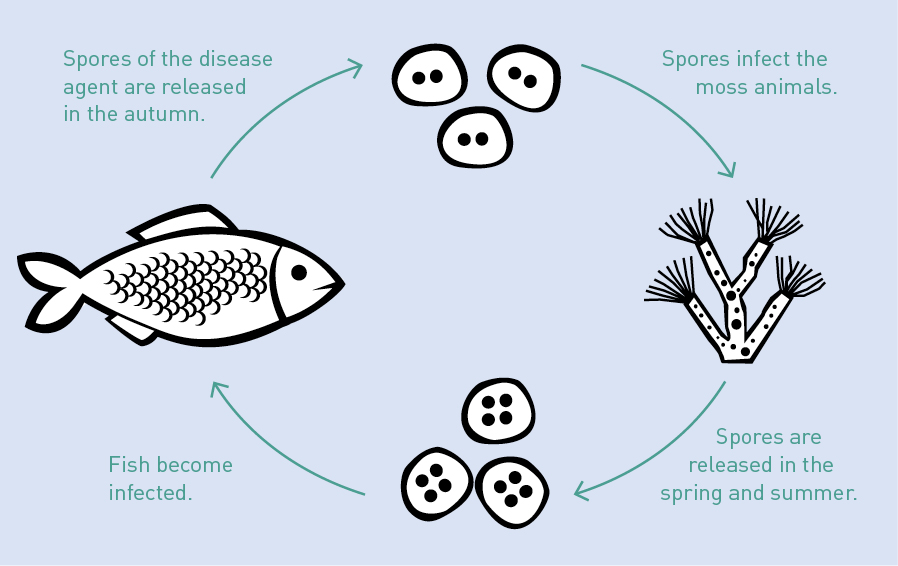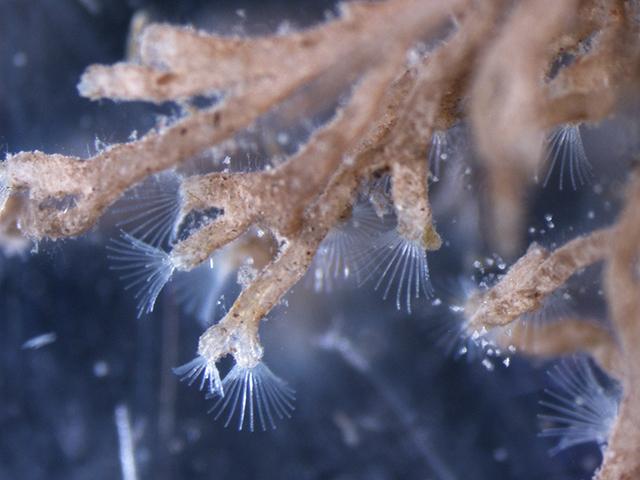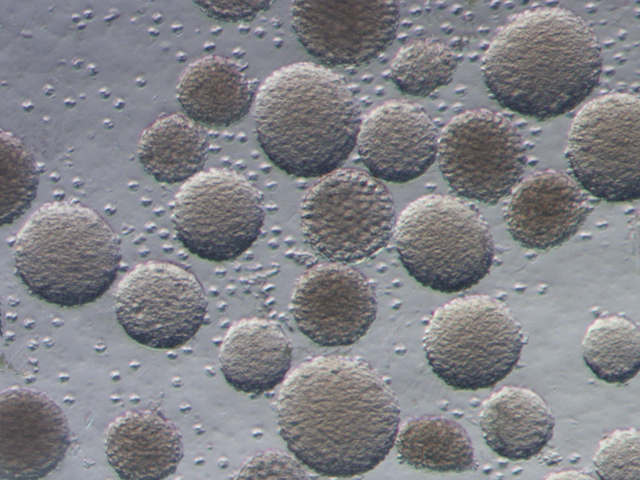A team effort
More and more fish in Swiss rivers are contracting proliferative kidney diseases. Researchers at ETH Zurich and Eawag are partnering to see how they can stem the tide.
At Eawag’s Aquatikum in Dübendorf, Switzerland, the basement is cool and loud, with a damp, swampland smell in the air. Snails, algae and other freshwater creatures flourish along a stretch of water that has been brought into a controlled environment. Powerful pumps have diverted a small part of the Chriesbach, a stream that flows past the recently opened research building, into the basement. There, water flows through basins and trickles down onto shelves equipped with glass plates and yoghurt containers.
For Hanna Hartikainen, a postdoc in the Aquatic Ecology research team, the main appeal of this “pond lab” lies in three small aquariums. Several glass plates hang in the water, on which a careful observer can detect a milky translucent growth – “moss animals”. Hartikainen is one of a handful of researchers worldwide who study these tiny invertebrates.
Complex host-parasite system
Moss animals, or Bryozoa, grow in colonies on the underside of stones and on tree roots that dangle in water. Research on these organisms focuses primarily on their role as a host for Tetracapsuloides bryosalmonae (Tbryo), the agent that causes proliferative kidney disease (PKD). PKD is a parasitic infection that affects mainly salmonid fish, such as rainbow trout, brown trout, char and salmon. The disease’s host-parasite system is extremely complex: in summer, Bryozoa releases Tbryo into the water in the form of spores, which infect the fish primarily via the gills. From there, the parasites make their way to the kidneys, where they grow and multiply. In this way, the fish itself becomes a host for the disease agent. In the autumn, the fish excrete infected spores through their urine, passing the infection to bryozoans.
Parasitic infection spreads
The fish normally show initial signs of the infection once the water temperature reaches 15°C. At that point the trout kidney, usually a thin red line running through the middle of the body, begins to swell to become a grey tube as thick as a human finger. On salmon and trout farms in the US and the UK, PKD can occasionally affect up to 90 percent of the stock. The disease has been present in Europe for a long time, but its spread has increased markedly in recent years: the first cases of PKD in Scandinavia were reported not too long ago. In Switzerland, the situation is becoming critical. In summer 2015, Hartikainen and her team conducted test catches in the Wigger River. At certain points, nearly all the brown trout they tested were infected with PKD.
Temperature has been identified as a key factor in the accelerated emergence of PKD. As long-term measurements from Swiss rivers show, water temperatures have risen by as much as 1.5°C within the past 30 years. In addition, the Centre for Fish and Wildlife Medicine at the University of Bern has demonstrated that at present, PKD occurs mainly in low elevations, where the water is warmer. “There is much to indicate that global warming both fosters the spread of bryozoans and also increases the mortality rate among infected fish,” Hartikainen explains.
Jukka Jokela, professor of aquatic ecology at ETH Zurich, assumes that other factors are also at play: “Rivers are being straightened, dams are being built and new chemicals are finding their way into the aquatic systems – all of which may promote the spread of bryozoans and PKD.” For example, it has been determined that crevices between concrete elements used for straightening rivers provide the perfect growth substrate for bryozoans.
A sample archive of 8,000 fish kidneys
Jokela and Hartikainen are presently investigating how the parasite interacts, genetically and immunologically, with its two hosts. Their work is part of a research project launched in February 2014 and funded by the Swiss National Science Foundation. Three partner universities are also involved in the project. Hartikainen works most closely with the Centre for Fish and Wildlife Medicine at the University of Bern. She regularly transports laboratory-grown bryozoans from Dübendorf to Bern, where fish specialists place them in large aquariums stocked with juvenile brown trout. After that, the researchers study the progress of the disease in relation to the parasite concentrations in the water, the temperature, and the genetic background of the parasite. In addition, the University of Bern (FIWI) has preserved and catalogued approximately 8,000 fish kidneys from Swiss rivers over the last ten years, testing them for PKD. “This data set is very valuable and opens up exciting opportunities for research. It was one of the reasons I moved to Switzerland from the UK,” Hartikainen says. By extracting DNA from the preserved kidneys, the researchers can accurately reconstruct how the parasite has changed over the years, potentially revealing adaptation to changing environments and hosts.
By the start of 2017, the project team aims not only to better understand PKD’s biology and epidemiology, but also to simulate its future spread. A third group, located at EPF Lausanne, is developing a model to create such predictions. The project also focuses on creating a basis for an effective way to combat PKD. For this reason, the University of Aberdeen has been looking into the parasite’s molecular characteristics, knowledge that could one day lead to a vaccine. “Our multidisciplinary collaboration is producing new and fundamental findings about PKD and the evolution of aquatic diseases in general,” Hartikainen says. “These range from the smallest of molecular interactions to the epidemiology of entire populations.”


